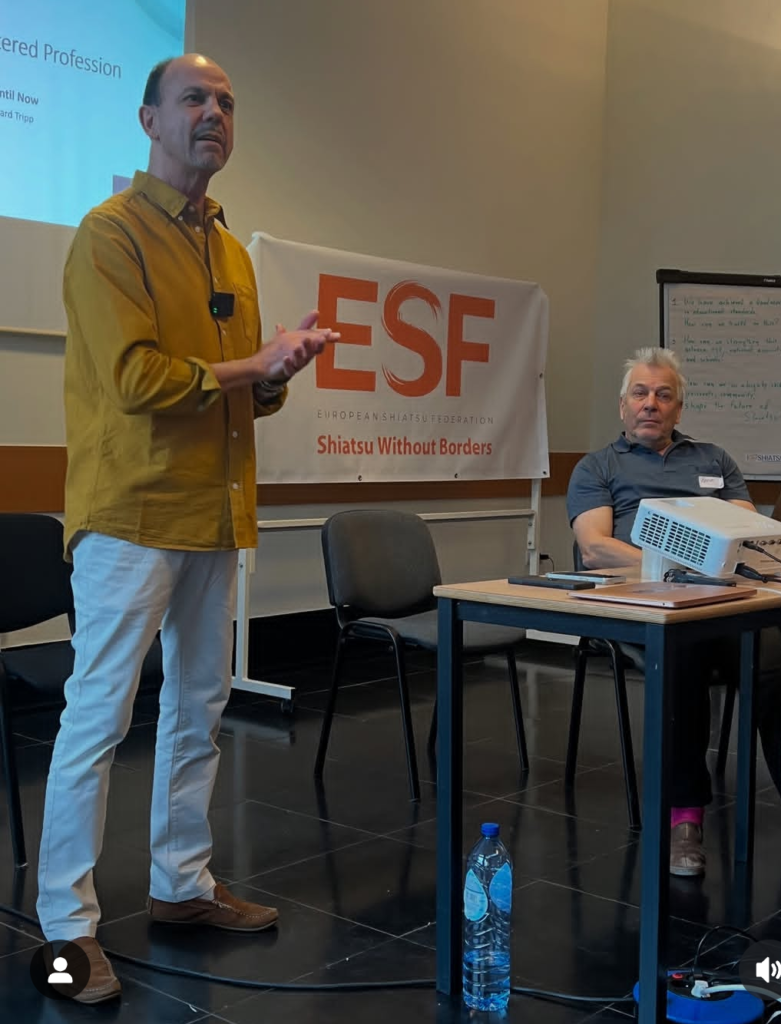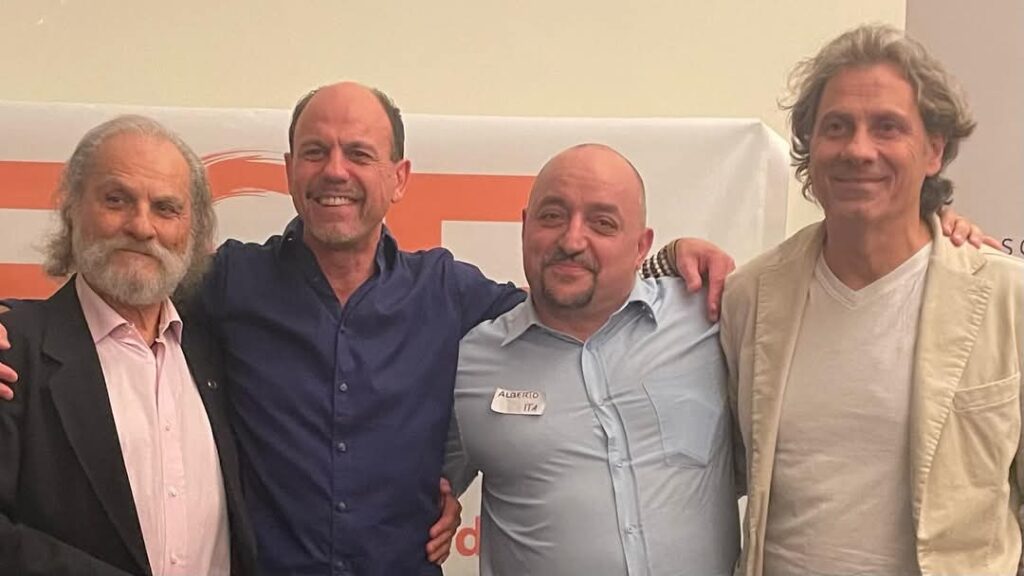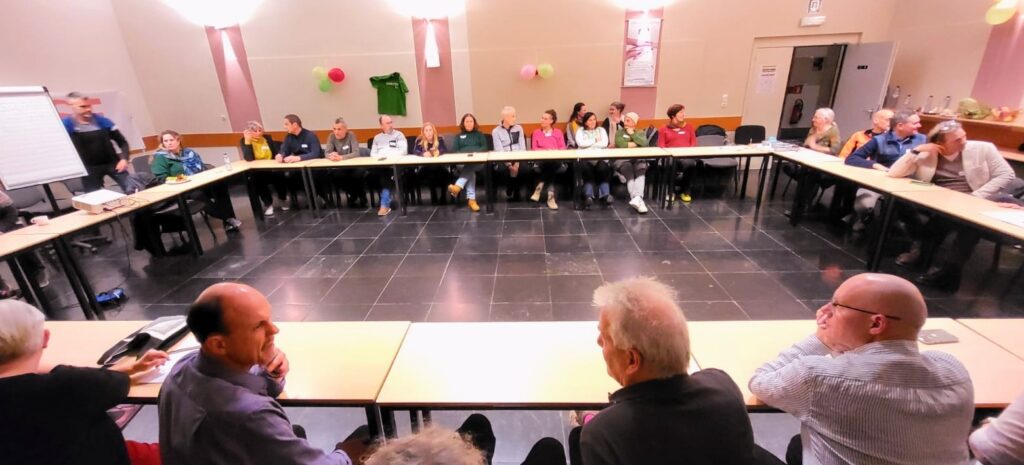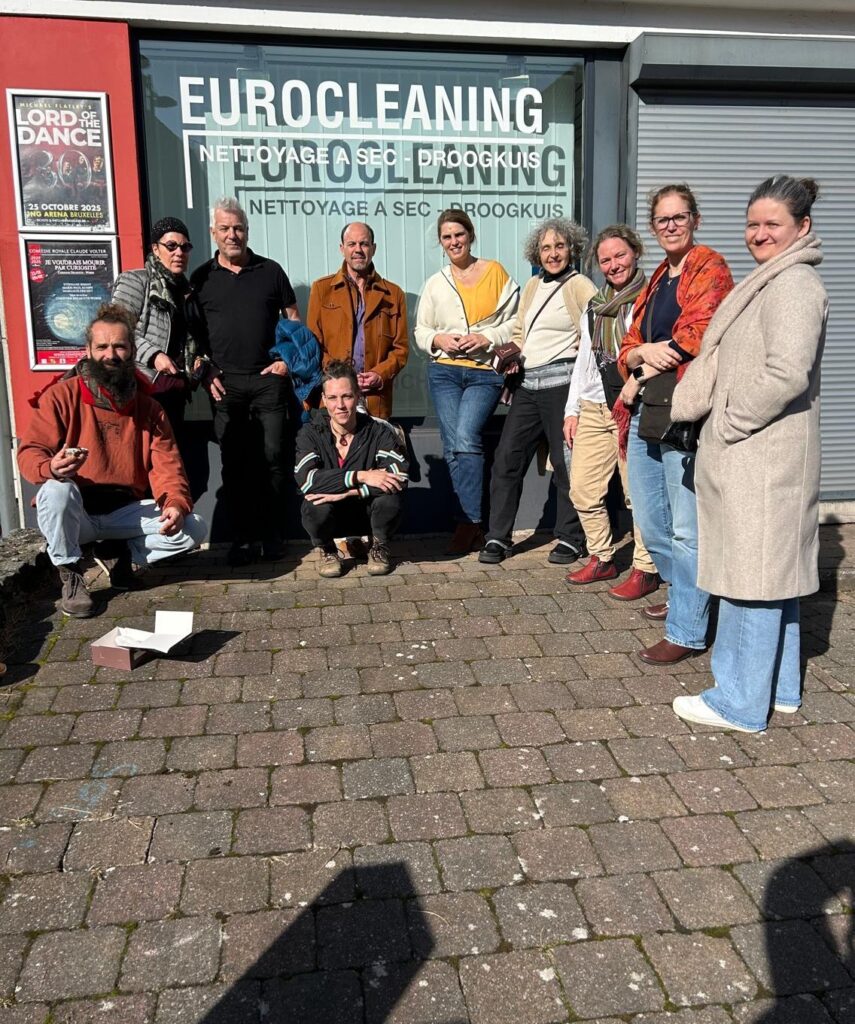On February 22, 2025, history was made in Brussels. For the very first time, representatives of Shiatsu associations from all over Europe and key players from countries in which such associations don’t exist yet gathered together. Hosted by the European Shiatsu Federation, the ESF, this landmark symposium brought together an impressive 56 participants from 22 different countries, including members of the International Shiatsu Network (ISN). The event marked a significant milestone in fostering unity, collaboration and shared vision within the European Shiatsu community.
Recognition of Shiatsu Through the EQF System
The main topic of this symposium was the proposal for the recognition of Shiatsu training through the European Qualifications Framework (EQF). This path, opened by the Austrian Shiatsu Federation (ÖDS), represents both a glimmer of hope for our profession and proof that recognition is possible. However, it also raises many questions and challenges for the future. The Ryōhō Shiatsu blog was invited as a media voice to further support European Shiatsu. This article serves as a report – an essential read to understand what is happening at the highest level among all European Shiatsu associations and what is shaping the future of our profession.
Over the past few years, the European Shiatsu Federation has undergone significant changes, opening up to all involved parties through its “Shiatsu Without Borders” initiative. Now, for the ESF, the focus is not on the federation itself but on the future of Shiatsu, its organization at the European level, and its accessibility to all national Shiatsu organisations. The entire board was present at the symposium, and the remarkable effort of bringing together representatives from 22 countries was widely acknowledged.
ESF president, Chris McAlister, began by recounting the origins of the ESF [1] and, more importantly, the strategies and hopes for Shiatsu, which, over time, have all met with disappointment, despite the efforts of previous presidents, especially the tireless Seamus Connolly, who acted as a lobbyist at the European institutions. Despite years of effort, the reality remains that no real breakthrough in official recognition was achieved. In 2014, then president Frans Copers asked Chris McAlister to take over the ESF presidency. During this presentation, the audience could appreciate the immense and long-standing work already accomplished (the history of the ESF can be downloaded here in English and German). The assembly was grateful to Mr. McAlister for being transparent about past strategies and partial successes as well as failures.

Four major initiatives have helped revive the ESF since 2014:
- Using soft power with European organizations and reharmonising the ESF from within to build a unified team with a shared vision.
- Irene Nolte and Antigoni Tsegeli’s idea of working with everyone, regardless of organization or country, which led to the launching of “Shiatsu Without Borders”.
- Snejana Stoeva’s initiative to launch an online platform sharing Shiatsu-related resources. The “Shiatsu Resources Worldwide” project provides access to concrete Shiatsu-related actions across the globe, along with discoveries of ancient texts, a library of modern works and much more. This site is set to cover an increasing range of topics in the future.
- Eduard Tripp’s proposal to pursue recognition through the EQF system, through the Austrian Shiatsu Federation (ÖDS). [2]
What is the EQF?
We have already introduced the EQF, the European Qualifications Framework, on this blog, but it is important to revisit the concept. The European Union was founded on several core principles, including the free movement of ideas, goods, services and people. One of the EU’s many challenges was to harmonize the qualifications of its citizens.
To achieve this, it created the European Qualifications Framework (EQF). While the Bologna Process regulated university education (bachelor, masters and doctorate) the EQF is altogether more comprehensive.
On the ‘formal’ side, it includes not only academic qualifications at levels 6, 7 and 8 (bachelor’s, master’s and doctorate) but also other formal qualifications that are not university qualifications, such as school-leaving qualifications, as well as qualifications from state technical training institutions.
On the other hand, and significantly, the EQF also covers non-formal training that is not, by definition, organised by the state, such as (in Austria) supervision at level 6, which is offered by a non-formal association.
The Challenge of EQF Recognition
One of the biggest difficulties in this process is communicating with European authorities in their own administrative language. This is why the work carried out by the ÖDS is essential – it allows other countries to save valuable time by working through the European Shiatsu Federation (ESF) and sharing the considerable progress already made.
What Does Level 6 Require?
To achieve EQF level 6, it must be demonstrated that practitioners:
- can manage a broad body of knowledge (Shiatsu techniques, anatomy, physiology, hygiene etc.)
- can handle the complexity of their profession and adapt to changes
- are able to present complex, subject-related problems and solutions to experts and develop them further in discussion with them

The Impact of Level 6 Recognition
Achieving level 6 is the equivalent of a bachelor’s degree, as standardised across Europe in the Bologna Process. This could have a huge impact on our profession since:
- Shiatsu training could be officially recognized, allowing the public to identify practitioners’ qualification levels and skills
- It could attract younger students, just as physiotherapy does
- It would demonstrate that Shiatsu is distinct from traditional massage in Europe.
If we consider the history of Shiatsu recognition in Japan, we see that it required proving its uniqueness compared to Anma therapy and Western massage. With this symposium and the ongoing work of the ÖDS, the ESF is now doing the same – 65 years later, but on a European scale.
A Historic Moment for Shiatsu in Europe
This first European symposium allowed all participants and representatives to understand that we have arrived at a turning point – a historic moment for our profession in Europe.
Importantly, once three EU countries achieve the same EQF level, the argument for the international Shiatsu community is much stronger to step up in terms of formal recognition across all EU member states. It is an essential step on the road for official European-wide recognition. This is not officially stated as a formal policy in any EU documents, but according to inside sources, it is an approach that makes logical sense.

The Challenges Ahead
Of course, this will not happen overnight – it requires consultation and perseverence. However, the reality is that across Europe, Shiatsu is in decline, except in Central and Eastern European countries (both inside and outside the EU), where it is still growing. The main challenges are:
- National Shiatsu organizations must show long-term political commitment and understand that while national lobbying is important, it is not the only path forward. European-level collaboration is crucial. In many countries, national barriers are nearly insurmountable due to internal policies heavily influenced by the pharmaceutical and medical industries, which often resist recognizing complementary therapies, partly because they generate little financial profit. Therefore, we must go beyond national governments.
- Another national-level challenge is countries with multiple Shiatsu organizations. However, Italy has proven that collaboration is possible. The joint presence of representatives from COS, APOS and Fisieo at the symposium demonstrated this very clearly. France, being the only other country facing a similar situation, may be able to learn from this example.
- Reaching EQF level 6 requires approximately 1,000 hours of training. This is still far from the Japanese standard of around 2,500 hours. This raises immediate concerns about school organization, as they may feel the need to professionalize, offer more courses and increase tuition fees accordingly. However, it is important to note that there are alternative models that allow schools to retain their current training standards and levels – the required additional hours can be offered, for example, either by the national association or through multi-school co-operation.
- Schools must be capable of providing strong courses in all subjects expected by European authorities. In addition to Shiatsu (at least 450 hours, regardless of style) schools will need to cover:
- Anatomy
- Physiology
- Hygiene
- Accounting
- Communication
- Healthcare and other national laws relevant to the practice of Shiatsu
Possible Solutions
During the symposium, participants suggested several potential solutions to address these challenges:
- If national authorities block progress, organizations should remind them that EU law applies to all member states and provide evidence of what has already been achieved under European regulations.
- For countries with multiple Shiatsu organizations, a contact group should be created with representatives from each organization and a single official representative for the European Shiatsu Federation (ESF). This representative will work on national representation within the ESF board, ensuring that their country’s voice is heard in the EQF process. Without this effort, countries risk having a standardized training system imposed on them, without their input – a situation that would be both illogical and unacceptable for practitioners.
- As is already the case in Austria, additional classes, courses and teaching hours can be organised by the national association or combined in one of the accredited schools to help lift the heavy load off the shoulders of the Shiatsu schools.
- A blended learning model (in-person and online) would also ease the burden on schools. Developing European-standard online training platforms, validated by the ESF, could greatly benefit Shiatsu schools, ensuring their sustainability. Additionally, this approach would help standardize non-Shiatsu-specific subjects across Europe, making training more consistent and accessible.

A Key Distinction: Recognition of Training vs. Recognition of the Profession
In conclusion, solutions exist, but it is important to keep one key point in mind. The EQF system recognizes training levels, not the profession itself. However, it is clear that since Shiatsu training has reached the bachelor’s level, official recognition of the profession will become much easier.
On this front, credit must be given to two of the ESF member associations: BSF, the Belgian Shiatsu Federation and COS, Coordinamento Operatori Shiatsu, have made an important first step by obtaining a specific NACE code for Shiatsu. NACE is the EU’s classification system for professions.
Proposals and Action Points
Throughout Saturday, participants and representatives gathered in discussion groups to develop ideas for future strategy. These ideas were then formulated in the plenary session, and the following action points were proposed:
- Define a common curriculum and examinations for each country.
- Establish a European ethical code for the Shiatsu profession.
- Organize more events such as meetings, congresses, presentations, training sessions and introductions within national organizations to increase interest in Shiatsu.
- Establish a European meeting every two years as a follow-up to this symposium and to ensure continued progress.
- Ensure that these proposals are communicated to national organizations for implementation.
- Create a Facebook contact group for all symposium members.
- Develop a shared online platform to exchange information on EQF recognition progress, curricula, educational materials and national training programs.
- Make national organizations’ professional and educational standards transparent, allowing comparison and collaboration between countries.
- In countries with multiple Shiatsu associations, create a unifying umbrella organization or contact group for representation within the ESF and EQF.
- Hold regular online meetings to maintain collaboration.
- Strengthen social media communication in each country to increase the visibility of Shiatsu.
- Since scientific research on Shiatsu is difficult to conduct, support research by first translating existing studies from Japan and other countries and make them available online. Additionally, compile a list of financial resources available for research.
- Develop national client satisfaction surveys after one or multiple Shiatsu sessions. This initiative will help practitioners improve client experience, and these testimonials will serve as evidence during negotiations with authorities.
- Publish and update medical advancements whenever they can support the cause of Shiatsu.
- Increase lobbying efforts with health insurance providers in each country to secure at least partial reimbursement for Shiatsu treatments.
- Create a “Shiatsu Ambassador” role for individuals with potential influence over national or European authorities.

Conclusion
Whether we like it or not, things are changing, and European Shiatsu has now embarked on a new path (to read more about EQF and Shiatsu, please read the official article on ESF’s website), supported by national organisations both within and outside the EU.
This gathering was the first of its kind on this scale and demonstrates that the profession has moved beyond outdated debates about different Shiatsu styles.
As a result, all Shiatsu professionals might reflect on and support this international effort across the continent. Anyone willing to help is welcome. It is also crucial for national associations and organisations representing Shiatsu to organise themselves and push these initiatives forward with the support of their teams.
The history of European Shiatsu is in motion, and the list of proposals above shows that momentum has begun. Never before has there been such a broad, transnational grassroots movement working together across borders to gain recognition for Shiatsu. For the first time in the history of Shiatsu, many key players have united, and we now have a clearer than ever understanding of the requirements and developments in different countries.
This marks a truly historic moment for our profession. Contact your national organisation to participate in the movement!
Notes
- [1] To watch Chris McAlister’s ESF story, click here on Youtube.
- [2] To watch Eduard Tripp explanations about EQF, click here on Youtube
Authors
- A Milestone: The 2025 ESF Symposium in Brussels - 24 March 2025
- Austria – 19-21 Sept. 25: Shiatsu Summit in Vienna – chronic fatigue, burnout & depression - 19 December 2024
- Terésa Hadland interview: Shiatsu at core - 25 November 2024
- Book review: “Another self” by Cindy Engel - 30 September 2024
- Austria – 24-26 Oct. 25: Master Class in Vienna – Shiatsu and martial arts - 20 August 2024
- France – Lembrun Summer Intensive Course – July 6 to 12, 2025: Digestive System Disorders, Advanced Organ Anatomy, and Nutrition - 4 August 2024
- Book: The Spirit of Shiatsu - 9 January 2025
- Shizuto Masunaga: his way of diagnosing – part.3 - 31 May 2023
- Shizuto Masunaga (part 2): His Creation - 9 January 2023
- Shizuto Masunaga (part.1): a genius on shoulders of giants - 6 October 2022
- The Blackened Pot - 15 June 2022











